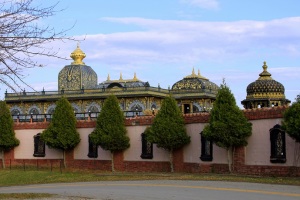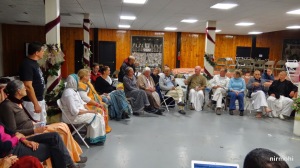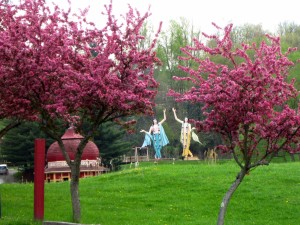Discussions at the New Vrindaban Community Dialog – Fall Board Meetings
New Vrindaban Fall Board Meetings 2014:
Community Dialogue Discusses Palace Wall and Succession
By Madhava Smullen
The recent Fall Board Meetings at New Vrindaban included a community dialogue on November 1st that brought up some lively discussion on pressing issues.
Community President Jaya Krsna Das and Palace Restoration Manager Gopisa Das first presented a proposal to renovate the boundary wall around the grounds of Prabhupada’s Palace.
The wall is falling apart and needs attention, Jaya Krsna said, as it is the first thing visitors see, and first impressions are important. He also pointed out that according to Gus Kayafas, the Wheeling architect who specializes in the preservation of historic buildings and is working with Gopisa on the project, the rustic appearance of the wall does not match the expectation created by the Palace’s opulent reputation.
Kayafas Architects’ proposal suggests that “the entire existing top course of block, rubble and decorative elements be removed and a new integral bond beam created. A precast concrete wall cap will provide the visual continuity. A sense of rhythm will be reinforced with a more refined stone pilaster with decorative stone inlay [of black granite]. The original colors of black and salmon will be utilized.”
This restoration plan would prevent the previous deterioration that had occurred due to water intrusion and poor construction techniques from happening again.
Sitting in a circle facing each other, board and community members discussed the proposal. Several devotees felt that the wall blocked the Palace from view, and suggested removing it completely. Others suggested putting up a wrought iron fence that the Palace would be visible through instead.
Jaya Krsna concluded the session by saying that the Prabhupada’s Palace Restoration Committee appreciated hearing from everyone, and would take the feedback into consideration during their decision-making process.
For the Community Dialogue’s second item, the New Vrindaban Community Advocacy Sanga, represented by Nityodita Das, brought up one of its main concerns, the need for succession in an ageing community.
The issue generated a lot of interest and opinions, with many devotees contributing to the lively discussion on how to attract younger devotees to live in New Vrindaban, and help them become situated as long-term residents within the broader community.
Several people brought up the need to plan a smooth transition from the student ashram to the householder ashram, develop a strong householder community, and have good income sources, a sense of community, and assistance with housing and land acquisition.
Board member Chaitanya Mangala suggested that concerns about acquiring land within the community could be eased by broadening the vision of what constitutes New Vrindaban to Srila Prabhupada’s grand request to “convert West Virginia into New Vrindaban.”
Jaya Krsna talked about how ISKCON New Vrindaban is already meeting some of the needs that were raised – the management has recently helped several devotees to move to the community and acquire land; there is a dedicated real estate manager to help devotees with land acquisition; and there are already about half a dozen independent companies within the geographic boundaries of New Vrindaban that provide employment opportunities.
What’s more, there are future plans for a building at Bahulaban where artisans and craftspeople could set up small businesses, as well as an ongoing discussion about how to attract more business owners to the area in general.
Jaya Krsna also pointed out that while ISKCON New Vrindaban management is doing what it can to help, the long-standing expectations that it be responsible for all the needs of the broader community are unrealistic and are a standard no other ISKCON organization is held to.
Chaitanya Mangala agreed, calling for a paradigm shift that would see a strong and vibrant householder community with a healthy temple environment at its center, something Jaya Krsna presented as a model earlier in the board meetings.
In the end, while there was no clear solution to an ongoing and complicated topic, the dialogue concluded with a collective resolve to continue exploring ways to attract young devotees to move to New Vrindaban, and to create an atmosphere that has them wanting to stay.





